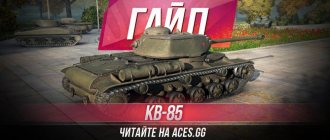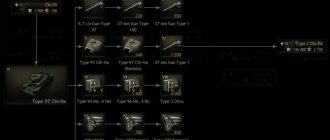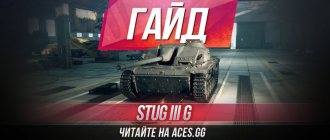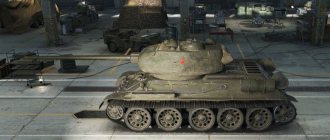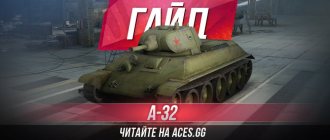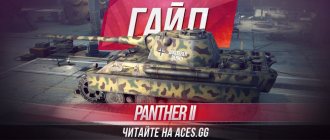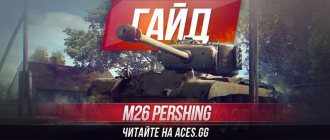Hello everyone and welcome to aces.gg! Friends and fighting friends, today our guest is a rather simple and unremarkable representative of armored vehicles in terms of performance characteristics, a British heavy tank of the fifth level - this is the Churchill I guide
.
This unit is the first strand in the UK development tree and it is worth saying that it perfectly characterizes the next two cars. This means that if you can play Churchill I World of Tanks
, then the next two cars will be familiar to you, since the gameplay on them will be almost identical.
Leveling up
- To switch from Valentine, 8,000 experience points are required. To switch from Matilda, 11,500 experience points are required;
- From the previous tank we got the WS No. radio. 19 Mk. II and guns: QF_6_pounder_Mk_III_UK, QF 6-pdr Gun Mk. V, 75 mm Gun Mk. V, which cannot be installed in a stock tower;
- You will need to study the Churchill III chassis and Churchill III turret;
- Next, you should study and install the top-end Bedford Twin-Six engine, which costs only 850 experience;
- Next, it makes sense to gain experience in installing the top-end 75 mm Vickers HV gun;
- And to make the tank elite, you also need to study the WS No. radio. 19 Mk. III, if it has not been studied previously, for example in the light tanks branch (starting from Covenanter) or the AT branch (starting from AT 2);
- Having finished with the layout of the tank, you can move on to studying the following vehicles.
Is it worth buying Churchill III
The tank has a good potential for earning credits and will help upgrade the crew well. Total cost 1500 gold. The machine will fully recoup the investment and will bring pleasure from the game to its owner.
Often during promotions there is a 50% discount on premium Tier 5 tanks. You can also get it using special bonus codes.
In the game client, 4 tanks with a preferential level of battles are currently available in the in-game store. If you are in doubt who to give preference to, we offer a comparative description:
Churchill has the highest DPM and armor penetration with a special projectile.
The highest safety margin and the best hull armor.
The mobility of the Soviet TT is higher than that of two medium tanks.
It is for its exceptional features and characteristics that Churchill III was included in our rating of the best premium vehicles of level 5.
Top equipment
| Price | 340,000 kr. |
| Strength | 700 HP |
| Weight/max. | 40.02/43 t. |
| Power | 350 hp |
| Speed | 25.7/14 km/h. |
| Agility | 22 °/s |
| Frame | 177.8/63.5/50.8 mm. |
| Tower | 88.9/88.9/76.2 mm. |
| Ammunition | 84 pcs. |
| Damage | 135/135/175 HP |
| Breakthrough | 145/202/38 mm. |
| Reload | 4.8 sec. |
| GN speed | 34 °/s |
| Angles VN | -4…+12° |
| Review | 350 m |
| Connection | 550 m |
First among equals
The defeat of the British Expeditionary Force in France in June 1940 had a sobering effect on British tank crews: it became clear that their equipment was not suitable for modern warfare. On a battlefield saturated with anti-tank artillery, light vehicles with bulletproof armor had no chance of survival, but heavier infantry tanks also turned out to be more vulnerable than desired. The machine gun Infantry Tank Mk.I could be discarded immediately, the cannon Infantry Tank Mk.II proved to be more useful, but also far from perfect. It was necessary to launch new vehicles into production as soon as possible: the enemy threatened to cross the English Channel and take the horseless tankers by surprise. Thus began the history of the Infantry Tank Mk.IV, or Churchill I.
Compromise tank
Work on the new vehicle began in July 1940. The A20 tank, which had previously been designed to replace the Matilda, seemed rather archaic compared to its German rivals, but we still didn’t want to completely abandon the concept. I still built a prototype of the car, but the tank already had a lot of complaints. One of the main problems was that the DAV's Meadows engine was not strong enough.
Experienced A20, predecessor of the Churchill
It was generally difficult with engines in British tank building at that time. The army did not spend money on developing new tank engines, believing that, if necessary, it would be possible to take a ready-made engine that the industry was already producing. And so it happened: they offered a replacement for the capricious Meadows DAV - the Bedford Twin Six engine. Indeed, it consisted of a pair of 6-cylinder engines produced by the Vauxhall branch, which performed well on trucks. The military liked the idea so much that they received the entire order for a new tank.
The new engine did not solve all the problems, and it was decided to stop development of the A20 and start designing a new car. From the A20, only the general concept remains in the new design. The decision to design a new tank turned out to be quite controversial: she had not dealt with such tasks at all before, although her engineers had at least some experience in mechanical engineering.
The customer did not set strict requirements. The vehicle was to have a three-man turret, a maximum speed of 16 miles (26 km) per hour, and an average speed of 12 miles (19 km) per hour. The most important thing was that production of the new tank had to begin in 1941, at least in small quantities. Reliability was not specified.
The appearance of the new car, which received the index A22, gradually emerged. According to the designers, the armor and armament of the tank should have been superior to its predecessor, but a problem arose with the implementation of the second point. The planned 57mm 6-pounder was undoubtedly more powerful than the 40mm 2-pounder found on British cruiser and infantry tanks of the time, but work on mounting it was stalled. By May 1941, the installation for the 6-pounder gun was being developed only for the Cruiser Tank Mk.VI "Crusader", and even then it remained so crude that the designers doubted that the development would be successfully completed before the "Crusader" was taken out of production.
Churchill engine, Borden Military Base Museum, Canada. The two halves of the structure are clearly visible
The successful development of the installation also did not solve all the problems: the production of the gun was not expected until October 1941, and the tanks had to be built immediately. The use of a triple mount with a 2-pounder gun, a 3-inch howitzer and a BESA machine gun was also discussed. Since such an installation also had to be built and tested first, the tanks were built with the proven 2-pounder in the turret. Since the A22, which at that time had already received the designation Infantry Tank Mk.IV, was positioned as a “universal tank,” the vehicles also received 3-inch howitzers in the hull. A similar solution was implemented on the French Char B1, but the British layout turned out to be slightly less archaic. The gun was served by a separate gunner, not a driver, and the gun was aimed horizontally without rotating the entire tank, albeit in a limited sector.
Since the 3-inch howitzer was considered a rather highly specialized weapon, the British considered it wasteful to produce all tanks of the new type with it, and together with the Infantry Tank Mk.IV a version called the Infantry Tank Mk.IVA was developed. This vehicle's howitzer in the hull was replaced with another BESA machine gun. Such tanks were equipped with a slightly different frontal hull part.
"Churchill" I at the Borden Military Base Museum, Canada. Double-tiered weapons and tracks covering the entire hull make it similar to the French Char B1
The tank's armor was designed to provide reliable protection against a 2-pound cannon when fired at point-blank range. Attached to the report with reservation requirements were tables of penetration of the 20-mm Madsen gun and the 14-mm Boys anti-tank rifle, which hinted that the designers were not going to send the vehicle into frontal attacks on 88-mm anti-aircraft guns. For a heavy tank this was quite small, but the thickness of the armor could not be developed indefinitely. The designers decided that an overall thickness of more than three inches (76 mm) would result in excessive weight gain.
Thus, the frontal armor was composite: the main armor 2.5 inches (63 mm) thick was attached to half-inch (12.7 mm) thick carbon-manganese steel plates, which in turn were attached to a non-armor steel frame. Such a clever design was needed to ensure that the tank did not fall apart during shelling, since slight deformation of the outer sheets, even when hit at a distance of up to 150 mm from the bolt, led to the nut breaking off. Tests have shown that this design can resist a 2-pound armor-piercing projectile from 400 yards (365 meters). On the other hand, even a very close hit did not lead to the destruction of the bolts. To work with rolled armor of such thickness, we had to rely on shipbuilding experience, fortunately there was enough of it in the country.
Column "Churchill" II. You can see the design of the driver's inspection hatch and the main difference between the vehicle and the Churchill I: instead of a howitzer, a machine gun is installed in the body
The roof and floor of the fighting compartment were 3/4 inch (19 mm) thick, the roof and floor of the engine compartment were 5/8 inch (16 mm) thick. The thickness of the driver's vision device armor was 3.5 inches (89 mm). The driver could open the hatch with the device to improve observation on the march, and when the shooting began, close it and observe through the triplex. Under heavy fire, the triplex was closed with a shutter. In this case, the driver could only observe through a periscope. Such a damper would have to be used even when coming under rifle and machine-gun fire, since the bullets ricocheted from the inclined frontal plate into the frontal plate of the turret box. Since the periscope could be damaged quite easily, the shutter was made so that if the fastenings were destroyed, it would fall off rather than get stuck in place. It was better to allow the driver to be vulnerable than to leave him blind.
The large 9" x 12" hatch was designed to remain in place when the hinges failed. The front plate also had two cutouts for a howitzer and a sight on the Churchill I, or one cutout for a machine gun on the Churchill II. The gunner had neither a hatch nor a triplex. He could only observe through a scope or a periscope. Due to the complex shape of the front plate, it was proposed to make it cast, but there were no enterprises in the UK that could cast such a part in the required quantities.
Churchill II Corps. The design of the parts was complex, and numerous cutouts weakened the armor
The side armor was made of armor steel 2.5 inches (63 mm) thick. The sides had fairly large openings for escape hatches measuring 22x15 inches. Like the driver's hatch, it was not supposed to fall out when the hinges were destroyed and was equipped with an opening system from the inside so that jamming would not doom the crew to death. In the center of the hatch there was a small hatch for firing a submachine gun. The hatch and hatch had an 8° bevel in thickness.
Unlike the A20, which had an old Matilda turret installed, a new cast turret was developed for the A22. Its prototype was cast in Chester, Philadelphia, so the turret was called “American”, despite the fact that in the series it was produced in the United Kingdom. The thickness of the tower armor reached 95 mm. There was no turret, and the crew commander observed the battlefield through a rotating periscope in his hatch. The fully loaded turret weighed 6.5 tons.
Shot "Churchill" I at the training ground. Separate cutouts in the front plate for the howitzer and sight are visible. Next to the first “Churchill” stands the last “Black Prince”. Photo from the collection of Yuri Pasholok
Canadian staff officer, Brigadier General F.F. Worthington had the opportunity to observe the testing of the A22 prototype on May 8, 1941. The tank impressed him. According to the general, the increase in booking was correct, which worked well on the Matildas in battles against the Italians in Africa. The new product proved to be faster than its predecessor and easily climbed slopes, craters and trenches.
The suspension and tracks made so much noise when driving that Worthington even wrote that in battle such tanks should be sent under the cover of aircraft so that the enemy would not hear them ahead of time. The A22's turning radius varied with gearing: in neutral it spun in place. Despite the weight of 38 tons, the new car was easy to drive. The weapons also impressed Worthington. The presence of the howitzer meant that the construction of a second variant for close support would not be necessary. The general was told that they were planning to install a 6-pounder gun on the tank. Already at this stage it was clear that the tracks protruding forward would lead to problems with a more powerful weapon. However, the Canadian ended his report with very optimistic words:
«This tank has not yet been tested in battle, but there are all signs that it will perform well. Only time will tell whether it will be able to replace cruiser tanks on the battlefield.”
Churchill's shield and sword
The opinion of the British military coincided with Worthington's high assessment. Serial production began in the summer of 1941, and the first samples came out in June. The tanks passed all possible tests.
Diagram of Churchill Tower I and II
The armor began to be tested even before production samples appeared. On May 13, the cast turret of the tank was fired upon. Tests were carried out with 2-pound armor-piercing blanks and 25-pound gun monitor shells.
The first shot from a 2-pounder from approximately 200 yards (183 meters) hit the rounded part at the bottom of the turret and penetrated through the armor with significant spalls within a three-inch radius of the hole. The second shell, fired from such a distance, did not penetrate the armor. Only a bulge was found on the back of the armor, but chips were noted on the outside. When firing at point-blank range, one shell ricocheted, the second got stuck in the armor without penetrating it, the third and fourth gave through cracks. The fifth shell knocked a 3x3 inch piece of armor out of the cracked part and smashed against the opposite side of the turret, leaving a half-inch deep gouge in it. Two more shells produced additional through cracks, but did not hit the armor. A hit from a 25-pounder did not penetrate the armor, but dented it to a depth of half an inch. With a nominal thickness of 95 mm, the armor at penetration points was from 91 mm to 98 mm thick.
Large escape hatches on the sides were not protected from penetration of lead splashes during shelling
The assembled corps was also shelled, but much later, on June 5. An almost assembled tank was tested, with the exception of the machine gun and the sight of the 2-pounder gun. The main purpose of the test was to shoot at the most vulnerable parts of the vehicle.
Shooting the evacuation hatch from a Lee-Enfield rifle from a distance of 10–25 yards showed that spray could still penetrate the tank, and the further away from the hatch hinges, the more likely it was. Firing through the embrasure of a cannon and machine gun also turned out to be effective, despite the external mask. The shelling of the opening for firing from a machine gun was not so effective. At this stage of testing, bullet fragments did not hit the tank at all.
After this, the tank was fired upon with an anti-tank rifle. 10 hits on the driver's inspection hatch hinges failed to jam it. Bullet reflectors welded to the sloping frontal part also withstood the fire. When firing at the undercarriage, the bullets pierced the tracks, but could not disable the track even when shooting at the fingers of the tracks.
Frontal detail of the Churchill. Special strips are welded to it to prevent bullets from being reflected upward into the forehead of the turret box. Separate cutouts for the howitzer and sight are noticeable. The Churchill II had only one embrasure
Firing the frontal armor of the tank with a 2-pounder proved to be more effective. Two hits merely dented the sloping frontal armor without penetrating it, but the third shell hit close to the top edge of the plate and deformed it so severely that the rivets were partially sheared off and came off. Testers noted that it is advisable to use welding to connect the hull armor sheets.
On July 9, 1941, one vehicle was fired at the Lulworth artillery range. It was a fairly short demonstration for senior officers, but a picture of the new tank's capabilities was already beginning to emerge.
The first to be tested was a 3-inch howitzer. The new type of smoke shells performed well: thick white smoke spread well across the field. An effective veil was created after 20 seconds and lasted for 75 seconds. The maximum firing range with this projectile was approximately 900 yards (823 m). Firing a 2-inch mortar on the roof of the tower was not as effective. The maximum shot range was only 95 yards (87 m), and the smoke screen was created very slowly, becoming effective after 30 seconds.
Diagram of Churchill suspension blocks. It turned out to be unsuitable for firing on the move
After the smoke shells, the gunner fired three high-explosive fragmentation guns at maximum elevation to calculate the firing range. The range turned out to be from 1100 to 1125 yards (1006–1029 m). After firing high explosive shells, the crew battened down the hatches and fired three more smoke shells to demonstrate the effectiveness of the ventilation system.
Significant problems were revealed when firing on the move. Since the car was quite crude, the speed was limited to 10 miles (16 km) per hour. The tank was moving along relatively flat terrain. With only 5 inches (127 mm) of suspension travel, the vehicle rocked violently even in such favorable conditions, and of the nine rounds fired from 750–1,000 yards (685–915 m), none hit the target. When driving parallel to the target, the tank performed much better: after eight shots, the testers counted six confirmed hits and one probable hit. A hatch for firing a submachine gun was also tested. The crew was able to quickly engage the silhouette of an infantryman positioned 10 feet (3 m) from the tank.
"Churchill" II on maneuvers. Even with the wings installed, the forehead of the hull is covered with an impressive layer of dirt
The tank fired high-explosive fragmentation shells at the anti-tank ditch in order to destroy its walls and allow it to be crossed. Having fired 14 shells, the car went ahead, but got stuck in a ditch. She was pulled out, and sappers blew up another part of the ditch with 200 pounds of explosives. After this, the tank was able to climb up the destroyed wall. "Covenanter" failed to cope with this task.
The cross-country ability of the new vehicle was also compared with another infantry tank, the Matilda. It happened on September 27, 1941. This time the obstacle was anti-tank ditches 8–9 feet (2.4–2.7 m) deep and 10–12 feet (3–3.6 m) wide. They did not become a serious obstacle for the new tank, but the Matilda got stuck during the first attempt to cross the ditch. But the Mk.IV also had problems: due to the lack of mudguards, the tank was heavily covered in a layer of mud when driving. It got into the barrels of guns and mortars, covered periscopes and even got into the turret shoulder strap.
Sports mileage
By the beginning of September, the tanks received new names instead of boring indices. The Infantry Tank Mk.IV with a howitzer in the hull was called “Churchill” I, and the Infantry Tank Mk.IVA with a machine gun instead of a howitzer was called “Churchill” II. The new names did not immediately take root among the troops, and the Mk.IV index continued to appear in documents. According to Winston Churchill himself, when his name was assigned to this tank, it turned out that the vehicle had many congenital defects. The prime minister did not utter the famous phrase “The tank that bears my name has more shortcomings than I do,” but the Churchill actually had quite a lot of problems, and they were not only related to the strange arrangement of weapons or fragile armor.
Churchill and "Churchill". Sir Winston was aware of the ambiguous fighting qualities of the machine baptized after him
Let's go back to 1940. Sir Harry Ricardo, inventor of the engine for the famous British Diamond Mk.V, was no longer working on tanks by the start of World War II. The talented engineer had good connections and periodically wrote angry letters to one or another lord, complaining about the disgusting state of British tank building. As you might guess, what irritated him most was the lack of a tank engine. Ricardo did not like the idea of adapting engines from wheeled vehicles or airplanes, since it would take the same amount of time as creating a new model. Much of the development time for such an engine would have been spent eliminating defects.
Ricardo also had plenty of complaints about Churchill. In the year since development began, the vehicle has grown in weight from 28 to 38.5 tons. The new engine solved the problem only partially; it had no effect on the reliability of the chassis. The efforts here have helped less noticeably. The meager track life of 20 miles (32 km), measured in the summer, increased to only 50 miles (80 km) by October 1941. The suspension also suffered. For a car of this weight category, Ricardo recommended getting rid of the springs and switching to a rigid chassis.
The Bedford Twin Six engine also had its drawbacks. Ricardo spoke flatteringly about the abilities of his colleagues from Vauxhall Motors, but did not hide the truth: the company had no experience in heavy engineering. The engine turned out to be fragile and unreliable, and when Ricardo’s company was called for help, it was too late. The only thing that a tank building guru could advise without radically altering the design was to deboost the engine to 300 hp. This idea did not find support: 50 hp. was already being taken away by the water and oil cooling system, and any further loss of power would have negated any superiority of the new engine over Project Meadows.
Transportation of "Churchill" on a conveyor. Due to the meager resource of the units, tanks had to be transferred this way, but there were very few tractors capable of transporting a 40-ton vehicle
Churchill also had enough problems with the clutch, transmission, and lubrication system. The design flaws were aggravated by the rather low quality of workmanship. This was reflected in the engine life: on July 20, 1941, it was only 9 hours! The service life of some units simply could not be determined, since the tank could not undergo any significant tests without constant stops. Replacing the engine proved labor-intensive - the process took six days at the Farnborough site - but there were still not enough spare parts available to allow such a luxury.
Another veteran of British tank building, Sir Albert Stern, also spoke negatively about the Churchill, but much more succinctly. As he believed, “the Mk.IV infantry tank is not suitable for combat and is already overloaded even with a 2-pounder gun.”
.
Lord Hankey, a supporter of Ricardo and Stern in the government, called the Churchill a “second-rate tank”
and
“at best a temporary measure
. According to him, such vehicles had to be kept near the coast so that they would not break down on the way to the battlefield in the event of an enemy invasion. According to Hankey, experts estimated the time it would take to turn the Churchill into a combat-ready vehicle at a year, if not more.
Churchill also had other critics - for example, the General Director of Research and Development of the Tank Department expressed his opinion that “the layout of the tank is a reaction to the request of the General Staff to reproduce the large assault tanks of the last war, and not a modern high-speed tank capable of long marches.”
.
"Churchill" was far from an ideal tank, but quite massive
There were even more complaints about the Churchill II: the armament, armor and maximum speed of the 38-ton giant were only slightly superior to those of the 25-ton Matilda. It turned out that the new tank was carrying an extra 13 tons for nothing! There is a caveat to this criticism: Lord Hankey lobbied on behalf of a group of designers with World War I experience who created the monstrous TOG I and TOG II. Hankey petitioned not so much for the Churchill to be replaced by TOG tanks, but for the promotion of his “old gang” to leading roles in British tank building.
However, the proposal to suspend production of the Churchills did not receive support. No one argued that the new tank had serious problems, but of all the vehicles in service, only the Churchill was developed after the start of the war. The second candidate for the role of a universal vehicle, the cruising Cromwell, was only at an early stage of development, and designing an infantry tank to replace the Churchill would have taken at least 18 months.
According to other officials, Churchill had no irreparable flaws. Stopping production and idle time of crude machines while waiting for modernization were considered unacceptable, and it was decided to send the Churchill to units as is. Tankers had to handle the tanks carefully and not drive at high speed, so that the vehicles would not become unusable before the designers cured their “childhood illnesses.”
Early type Churchill column. By the end of 1941, it was already possible to believe that such a procession would not end in a nightmare for repairmen
The reliability of the Churchill did indeed gradually increase. In September 1941, the tanks were tested in the training operation "Bumper". Among many other units, three armored divisions and two army tank brigades took part in the massive four-day maneuvers. According to the terms of the mission, British and Canadian units counterattacked German armored units, which successfully created a bridgehead, broke through the coastal defenses and went deeper into the island. In such a situation, British tanks were required to take quick and decisive action to intercept the enemy group, but the Churchills did not quite cope with the task.
To save resources, tankers were prohibited from using the highest gear, limiting vehicle speed to 10 miles (16 km) per hour. Despite this, half of the Churchills required repairs during the maneuvers, and by the end of the exercises, 40 tanks out of 54 required repairs. After 48 hours, 11 Churchills still remained in the workshops. The average mileage per vehicle per operation was 150 miles (240 km). The tank's reliability and average mileage turned out to be much worse than that of the Valentines, Matildas and Covenanters, which also took part in the maneuvers. On average, tanks of other types traveled 225 miles (362 km) - one and a half times more.
At the beginning of December 1941, two production tanks were tested again. The vehicles completed the 65-mile (105-km) march along the concrete track without any breakdowns. On the second day the run was successfully repeated. After the top gear ban was lifted, the average speed was 14 miles (22.5 km) per hour. The tanks traveled 0.85 miles (3.3 liters per kilometer) on a gallon of gasoline, which turned out to be even better than required. At the same time, an experimental vehicle was tested, which traveled 700 miles (1126 km) without serious breakdowns. Vauxhall also developed new tracks with a service life of 2,000 miles (3,218 km).
Churchill II with a dummy 3-inch howitzer instead of a machine gun, Bovington Tank Museum. The letter “R” in the registration number means that the car has been modernized
The reliability of tanks was increased by improving crew training and improving production quality. Of the 22 serious defects, by mid-December 1941, 20 were considered corrected. The military has set a specific requirement for vehicle reliability: the ability to drive 60 miles (100 km) per day for six consecutive days. By the end of 1941 this goal was just around the corner.
The reliability of the new vehicles was promising, but the old tanks had to be raised to this level. There were quite a lot of them: on November 27, 1941, there were 381 Churchills in the Royal Tank Forces, 111 of which were no longer suitable for combat use and required major repairs.
The modernization program began to gain momentum in early 1942. By the end of January, it was planned to modify 50 vehicles, and by March it was expected to modernize 700 tanks out of 1000. According to experts from the Ministry of Supply, the first 300 Churchills released were impossible to bring into combat-ready condition, and they were going to be left in the metropolis as training ones. The service life of capricious tanks could be preserved by transporting them on special transporters. There were not enough vehicles in the UK capable of lifting the Churchill, but the Americans promised to supply 300 units for this.
By the end of 1941, the situation with Churchill had more or less stabilized. The German war machine stalled in the USSR, and the threat of invasion of the British Isles receded. There was no longer a need to feverishly produce “second-rate” tanks, and the quality of the vehicles produced began to increase. Although replacements for the Churchills I and II arrived fairly quickly, no radical changes were introduced to the design of tanks of this family until the end of World War II.
Sources and literature:
- Canadian Military Headquarters Archive, London (1939–1947) RG 24 C 2
- The National Archives of Great Britain
- The Canadian Army at War: The Canadians in Britain, 1939–1944 - King's Printer, 1945
How to play and tactics
An excellent support tank and a successor to Matilda traditions. The accurate gun allows you to shoot even at long distances, since the Churchill I does not always have time to enter close combat due to its low mobility.
In certain cases, it plays into its favor: the tank is not bad when shooting on the move, especially when moving on city asphalt or other flat surfaces. Due to the penetrating and accurate top gun, as well as good visibility, the tank is effective at all distances.
In close combat, problematic mobility and weakness of armor without tilt angles may begin to affect it. The front rollers are located in front of the hull, which allows, if necessary, to use risky tactics - exposing yourself to inexperienced opponents to shoot at the track without damaging the tank.
Such a maneuver is permissible only if you are sure that immobilization is not critical in the current situation, for example, when squeezing a lone enemy out of cover in a group. It is important to remember that when “tanking” with front rollers and tracks, you must have a toolbox, as well as the crew’s “Repair” skill. Otherwise, a situation may arise in which the enemy finds a place where the damage passes, and Churchill I will simply be dismantled while he is motionless.
Equipment for Churchill III
Having studied the weaknesses and strengths of the tank, you will have to make a choice of installing equipment that will help reduce the impact of the disadvantages or increase the effectiveness of the advantages. Due to its performance characteristics, Churchill III has several configuration options:
- reinforced aiming drives will help to aim faster, which will contribute to the implementation of high DPM. Mandatory for installation, since long convergence is the main drawback of the weapon;
- improved ventilation Class 3 - a 5% increase in crew skills will increase all the characteristics of the tank, including the aiming time, which is so important for us.
The choice of equipment for the third slot depends on the individual preferences of the player:
- medium caliber gun rammer - will increase the rate of fire and increase the average damage per minute. This will give an advantage in a shootout with the enemy at close range, when there is no need to fight to the end;
- coated optics - will add 35 meters to the basic review, suitable for players who cannot wait long and are eager to move forward. At the end of the battle, it will allow you to more effectively resist tank destroyers sitting in the bushes.
- anti-fragmentation lining - will help you survive longer under artillery fire and against high-explosive enemies, and increase survivability in battle.
Historical reference
The history of the heavy infantry tank "Churchill" began in September 1939, when the General Staff of the British Army developed a technical specification for the A.20 tank, which was going to replace the heavy infantry tank Mk II "Matilda", which was already in mass production and was entering service with the troops. It was mass-produced from 1941 to 1945 and became one of the most numerous British tanks of World War II.
Like other British infantry tanks, the Churchill was distinguished by an outdated design, weak armament and very low mobility, but extremely thick armor for its time (101 mm, later increased to 152 mm) allowed it to fight relatively successfully until 1945.
After the end of World War II, the Churchill was soon withdrawn from service by the end of the 1940s, but a number of the flamethrower version of these tanks still took part in the Korean War.
Crew training
The process of learning skills on this device, as on any other, plays a very important role. The selected skills can not only complement the effects of the installed equipment, but also improve more highly specialized parameters, and in general it is beneficial to increase the characteristics of the tank. In order not to make mistakes, it is better to distribute perks on Churchill I
as follows: • Commander (radio operator) – , , , . • Gunner – , , , . • Gunner – , , , . • Driver mechanic - , , , . • Charger – , , , .
